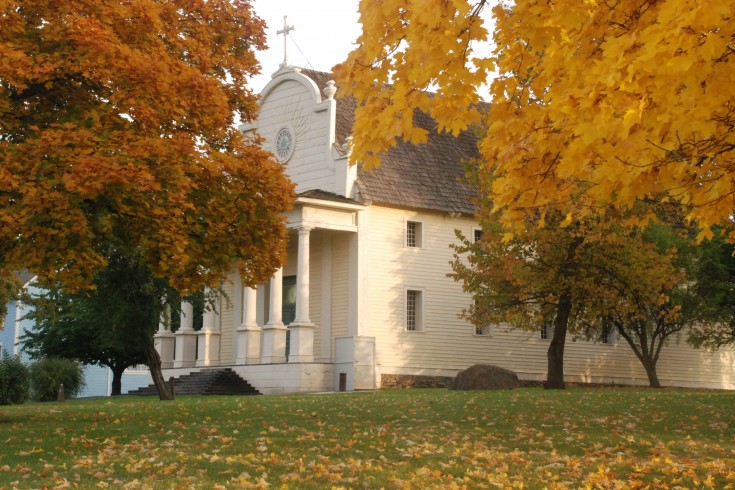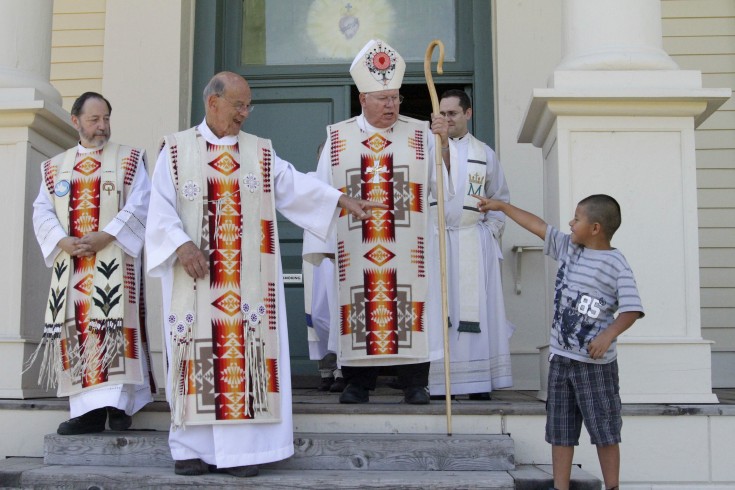Union of Native American and Christian Beliefs Documented in Exhibit
-
 Jack McNeelThe Sacred Heart Mission was built by Coeur d’Alene tribal members from 1848-1853 with limited tools and no nails and remains standing today. It is the oldest standing building in Idaho.
Jack McNeelThe Sacred Heart Mission was built by Coeur d’Alene tribal members from 1848-1853 with limited tools and no nails and remains standing today. It is the oldest standing building in Idaho. -
 Jack McNeelCoeur d’Alene tribal members return to the Mission each August for the Feast of the Assumption. Here, Father Tom Connolly jokes with a youngster during one of those returns a couple of years ago.
Jack McNeelCoeur d’Alene tribal members return to the Mission each August for the Feast of the Assumption. Here, Father Tom Connolly jokes with a youngster during one of those returns a couple of years ago.
Chief Circling Raven of the Coeur d’Alene Tribe had a vision back in the 1700s of men in black robes who would come to the tribe. Chief Shining Shirt of the Pend Oreille Tribe in Montana had a somewhat similar vision. Neither man lived to see that day but later generations were visited by the “Black Robes,” Jesuit priests of the Catholic Church.
Father Pierre Jean De Smet arrived in the Bitterroot Valley of Montana in 1841 and a year later traveled westward to meet with the Coeur d’Alenes. Others came soon after and a small mission was built in 1843 along the St. Joe River. It proved undesirable due to springtime flooding and a new mission was begun in 1848. This mission was built by members of the tribe under the guidance of missionaries and was completed in 1853. They had limited tools and no nails, yet that mission—the Sacred Heart Mission—still stands today, Idaho’s oldest standing building. The church and the tribe have had a close relationship ever since that first meeting.
In the 1990s a massive exhibit was created documenting this meeting and union between two sacred worlds, that of the Christian faith and the indigenous beliefs of the Native Americans. That exhibit required 8,000 square feet of space and toured the country until 1996. It has now been reassembled but with modernized technology and will become a permanent exhibit at Old Mission State Park on Coeur d’Alene tribal lands. Items from numerous prestigious museums such as the National Museum of the American Indian, the Holy Names Heritage Center and many others are now on loan here.
A new visitor center has been built with 9,000 feet of space, 5,000 feet of that space will contain Sacred Encounters: Father De Smet and the Indians of the Rocky Mountain West. Cost for the project was $3.26 million with many organizations and individuals contributing. The Coeur d’Alene Tribe and the Harry F. Magnuson Family Foundation were two of the major contributors. Magnuson was a wealthy mining magnate in the area and a long-time friend of the Coeur d’Alene Tribe.
Sacred Encounters was formally dedicated on October 15. About 200 people gathered under a tent for a 90-minute ceremony beginning with a drum circle and songs, several speakers, lots of thank-you’s for the 14-years of hard work required to bring this moment to conclusion, then a walk to the newly built visitor center and a traditional ribbon cutting ceremony.
Old Mission State Park, also called the Cataldo Mission, is managed by the Idaho Department of Parks and Recreation, yet is owned by the Coeur d’Alene Tribe. The Roman Catholic Diocese had owned the buildings and land around them since the mid-1800s. In a unique agreement in 2002, ownership of the land and facilities were transferred to the tribe because of the long historic and spiritual connection to the Coeur d’Alenes. It is listed as a National Historic Landmark on the National Register of Historic Places. It is also the most visited heritage park in Idaho with more than 100,000 visitors each year.
The 18 acre park includes the new building housing the Sacred Encounters exhibit, an 1853 mission building, an 1887 parish house, two cemeteries, plus trails through the grounds with interpretive panels and audio stations. Every August 15 the Coeur d’Alene Tribe hosts the Feast of the Assumption Pilgrimage.
“This display will rival any Smithsonian display in Washington D.C.,” Nancy Merrill, director of Idaho’s Parks and Recreation Department, said. “People should come and see this, and realize what an important event this is and how substantive and comprehensive it is. They will be amazed. People need to bring their grandchildren.
“This is a special place. It is a sacred place, and you will have a sacred encounter when you walk through those doors. You learn of the history of the roots of this wonderful Coeur d’Alene Tribe here in this valley and what it meant to them as they joined together with the Catholic Church and became one in purpose.”
Jeannie Givens, Coeur d’Alene tribal member and former state representative, had similar comments. “This represents a good explanation of the situation where we have first contact with the missionaries. This exhibit attempts to not gloss over important issues surrounding the missionaries. It also is a story about the fur traders. It’s a story about spirituality and it’s just wonderful that all these artifacts have returned home here among the Coeur d’Alene people. Cataldo is a sacred site for all of us and now it’s even more sacred because of this exhibit.”
Father Tom Connolly retired last year after serving and living with the tribe for 33 years, but he’s still active in Indian events and was one of those asked to speak at the dedication. He told of the problems early missionaries saw, of tribes “just flooded over with white settlers” and how Father De Smet had a beautiful vision of reducing this white contact “where they could make adjustments in their own way and in their own time. That was his dream for these missions in what he called the Rocky Mountains.”
It was during this time of settlers and miners arriving here that the tribe moved south and west and erected a new mission at what became known as DeSmet, Idaho where they were less intruded upon by white prospectors and miners.
“These tribes had a beautiful spirituality which was based on the kinship of all creation,” Father Connolly said. “People in Western culture see people as one level and the animals and the earth to be merely used. They (tribes) found their power in their spirituality. As far as we can tell there was no concept of a high God and this was one of the ideas Father De Smet was able to bring, of a high creative God who wanted to come and be a part of his creation and show us the way in the person of Jesus.”
Father Connolly spoke of how difficult this was for some, and yet toward the end of the 1800s “chiefs made a horseback trip to Walla Walla asking for lady Black Robes to come and teach their girls.” A beautiful large brick school was built at DeSmet for girls and another for boys. “There has been this relationship in spiritual ways and economic ways through all these years in a gradual integration of two different cultures, at times beautiful and powerful and helpful while at times really difficult and painful. We’re here today to overlook some of those painful times of the past, to celebrate the wisdom and beauty of the tribal leadership in bringing these two worlds together. It really is a sacred encounter.”
Ernie Stensgar, vice chairman of the tribal council, spoke for the tribe, thanking all those who helped put the exhibit together. He also talked of those who helped but are no longer with us: Henry SiJohn, Laurence Aripa, and Richard Mullen were three he noted. “The Mission here is a huge artifact that belongs with the exhibit,” Stensgar said. “If you look at the correlation of the church and building it and having it as a sacred site along with the many items in the exhibit, it all comes together. Generation after generation has always come here to remember their spirituality, to remember their ancestry, and it’s a holy place for us.”
A surprise visitor was Ambassador Jan Matthysen of Belgium. He acknowledged it might have been a surprise to others but not to him. “I had to be here and I will explain why that is. Once you enter the Belgium Embassy in Washington, the first thing you see is a big picture of Father De Smet. Why is that? He is extremely important for the relationship between my country and the U.S.”
The ambassador explained that Father De Smet was a legendary figure in Belgium and an inspiration to many children and through him they had a certain vision of Native Americans. “Part of my job is to promote the memory of Father De Smet in a continued substantial and strong way. I’m extremely grateful to all those involved with the museum. I feel honored and pleased to attend.”
He was presented with a replica of a small eagle staff that tribal member Calvin Nomee had built, and his wife was given a beaded medallion.
Following the ribbon cutting, visitors were allowed to enter the museum and view the exhibits. One walks from room to room through nine scenes with videos and music playing in addition to the static displays. There are Native American items such as early clothing, bags, and dolls and there is a seven-minute audiovisual program of the spiritual world of the Salish tribes. Another scene reflects life of the tribe before the missionaries arrived and a later scene reflects the early Reservation Era. There are numerous items from the Catholic Church including a letter by Father De Smet, a Bible from that period, a polished chalice, and the centerpiece is a re-creation of the Mission on Christmas Eve in 1842. Other items came from Father De Smet’s birthplace in Belgium and one scene documents much of his life with the Indians.
The entire museum is built to standards required by major museums with humidity and temperature controls to protect the items.
Tribal elder Felix Aripa summarized what many were feeling. “It’s good to be here. We’re all here like family. We’ve finally finished our work. We want to extend this unity with the rest of the world.”
© 1998 - 2011 Indian Country Today. All Rights Reserved To subscribe or visit go to: http://www.indiancountry.com